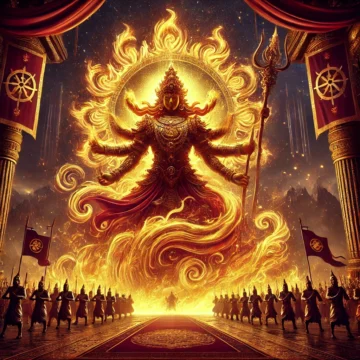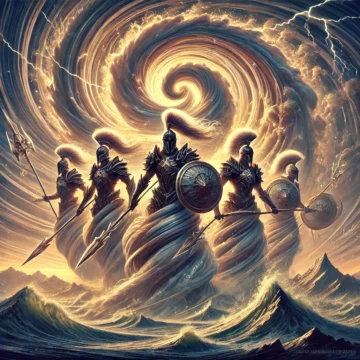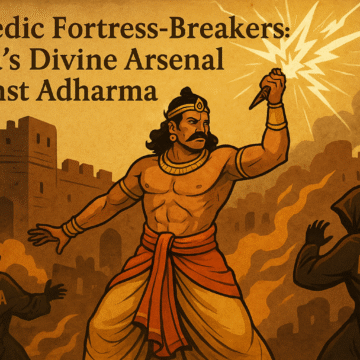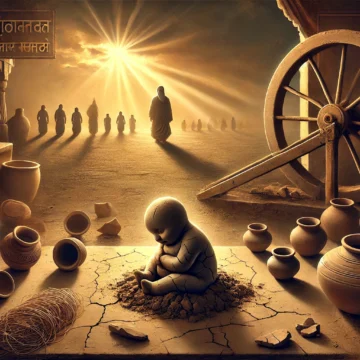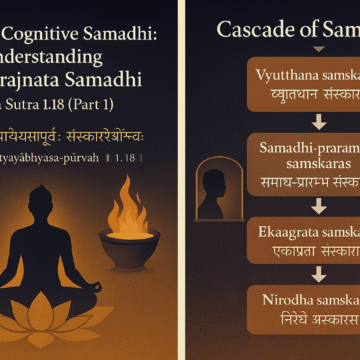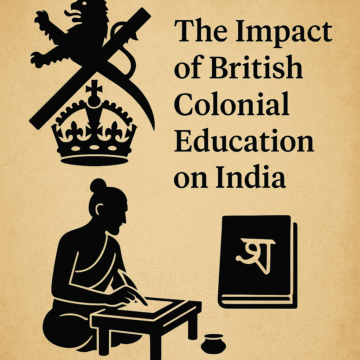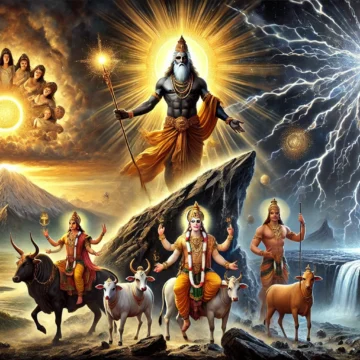यह लेख बताता है कि कैसे “नरसंहार” का आरोप एक प्रचार हथियार बन चुका है, जहाँ नागरिकों की रक्षा करने वालों को अपराधी और जानबूझकर नागरिक मौतें कराने वालों को पीड़ित बताया जाता है। संयुक्त राष्ट्र, मीडिया और अंतरराष्ट्रीय क़ानून के माध्यम से यह नैरेटिव कैसे वैश्विक स्तर पर स्थापित किया गया, इसका तथ्यात्मक विश्लेषण प्रस्तुत है।
Author: Sarvananda (Sarvananda )
KBC Exposing Authority Collapse in Human Manufacturing
A single moment on KBC revealed a deeper civilizational failure: the collapse of authority in modern human formation. This article examines how dismantling hierarchy, discipline, and correction—under the guise of equality and rights—has distorted human manufacturing. Drawing from Hindu philosophy, it argues that structured authority is essential for upright, responsible individuals and social stability.
इस्लामी सत्ता का विरोधाभास
यह लेख धार्मिक ग्रंथों में निहित उस संरचना का विश्लेषण करता है जहाँ दूत की आज्ञा को ईश्वर की आज्ञा के समकक्ष रखा गया है। पाठीय उदाहरणों के माध्यम से यह दिखाया गया है कि यह व्यवस्था व्यवहार में कैसे दंड, कानून और आधुनिक प्रवर्तन प्रणालियों को प्रभावित करती है, जिससे “इस्लामी सत्ता का विरोधाभास” उत्पन्न होता है।
गाज़ा की बर्लिन दीवार: जब हमास का पतन होता है तब क्या घटित होता है
यह लेख “गाज़ा की बर्लिन दीवार” को केवल एक भौतिक अवरोध नहीं, बल्कि आंतरिक संगठनात्मक और मानसिक नियंत्रण प्रणालियों के विरुद्ध प्रतिक्रिया के रूप में प्रस्तुत करता है। यह दर्शाता है कि मिस्र सहित सत्तावन मुस्लिम राष्ट्रों ने इतिहास से सीख लेकर शरणार्थियों और समानांतर सत्ता संरचनाओं के बीच स्पष्ट अंतर क्यों किया।
Bhava Pratyaya Videha Yogis: Spiritual Privilege And Rebirth (Yoga Sutra 1.19)
Bhava Pratyaya Videha Yogis represent inherited meditative capacity carried across lifetimes, granting effortless access to profound samadhi. Patanjali warns that such absorption—whether bliss-based or cosmic—remains within nature unless completed by viveka-khyāti. True liberation arises not from experience alone, but from discriminative wisdom that dissolves even subtle bondage.
KBC and the Plumb Line: When a Society Loses Its Moral Measure
This article explores how modern society abandoned its moral plumb line, leading to collapsing discipline, confused rights, and fractured families. Through Hindu principles of dharma, balanced reward–correction, and compassionate firmness, the piece explains why early guidance forms character and why false kindness creates long-term harm. A call to restore structure and rebuild human formation.
Rigvedic Fire-General: Agni as Army Commander – Rigveda 1.66
Rigveda 1.66.5-8 reveals Agni as strategic commander—eternal will incarnate, brilliant as golden chariots in battle, commanding like an army rushing to attack, operating with twin-force across present and future. These verses establish Vedic doctrine of organized defense under righteous leadership, completing the canonical triad with Indra's fortress-breaking and Maruts' shock-troops for civilizational protection.
Beyond Liberation: Videha, Prakriti-laya (Yoga Sutras 1.18-1.19)
Even the most sublime yogic states—Videha and Prakriti-laya—are revealed to be subtle forms of bondage in Patanjali’s Yoga Sutra. This blog explores how these states, while appearing like liberation, still bind the yogi through attachment. It introduces three authentic post-death paths—Sadyo-mukti, Krama-mukti, and Avatāra—and explains the deeper role of Viveka-khyāti and Bhava-pratyaya.
KBC Guru to Guide: Not Just a Teacher
When the Guru became a teacher, and the teacher a tutor, the sacred science of human construction collapsed into content delivery. This blog analyzes how ancient traditions shaped character with friction and force, while modern systems fear discipline. The guru was a potter — today’s tutor is a performer. The result? Bricks without buildings.
Patanjali Yoga Sutra Terms Explained: Understanding Yoga Sutra Terms-II
This expanded glossary completes the essential vocabulary needed to fully understand Patanjali’s Yoga Sutra, especially the profound teachings of 1.18–1.19. Covering advanced sadhana, post-death paths, psychological pitfalls, and subtle distinctions, it clarifies how abhyasa, vairagya, samskaras, and liberation processes interconnect—revealing the entire spectrum from effort to Kaivalya.
Patanjali Yoga Sutra Glossary: Understanding Yoga Sutra Terms-I
Struggling with complex Sanskrit in the Yoga Sutras? This glossary simplifies 36 key terms from Patanjali’s Yoga Sutras 1.18–1.19, focusing on Samadhi, samskaras, kleshas, and Sankhya philosophy. Gain clarity on Nirbija, Viveka-khyati, and Purusha-Prakriti to unlock Asamprajnata Samadhi and deepen your spiritual understanding. Ideal companion for beginners and advanced yoga practitioners alike.
Rigvedic War-Host: The Maruts as Divine Shock Troops
The Rigvedic hymn 1.64 presents the Maruts as a unified storm-host embodying the protective power of ṛta. Far from mere poetic embellishment, traditional and modern commentaries show the Maruts functioning as guardians of order who remove obstacles, strengthen communities, support rightful authority, and provide the inner resilience needed for civilizational continuity and collective defense.
Practice of Para Vairagya – Yoga Sutra
Patanjali’s Yoga Sutra 1.18 reveals the Practice of Para Vairagya—the supreme detachment that leads the yogi beyond all cognition into Asamprajnata Samadhi. Through Neti-Neti and repeated practice, the mind’s fluctuations cease, leaving only the subtle impressions of stillness. This process culminates in freedom, where consciousness rests in its own radiant nature.
Rigvedic Fortress-Breakers: Indra’s Divine Arsenal Against Adharma 1.63
Rigvedic Fortress-Breakers reveal Indra’s battlefield doctrine — the divine authorization for self-defence rooted in Vedic dharma. Hymns 1.63.2–1.63.7 depict fortress-breaking, slaying of Dasyus, and divine protection for kings and sacrificers. Far from metaphor, these verses establish a Vedic right to resist annihilation and preserve sacred civilization against Adharmic conquest.
Manufacturing Defect: When Humans Stopped Making Humans
Modern society celebrates intelligence but ignores humility and discipline—creating incomplete humans. This blog exposes the “manufacturing defect” in parenting and education where children are treated like finished pots before being fired in life’s furnace. Drawing from Hindu wisdom—tapa, danda, and the guru’s authority—it calls for restoring the lost art of manufacturing strong, responsible, compassionate human beings.
Beyond Cognitive Samadhi: Understanding Asamprajnata Samadhi
Asamprajnata Samadhi, described in Patanjali’s Yoga Sutra 1.18, is the transcendence of even the most refined meditative cognition. Through Para Vairagya—supreme detachment—every mental modification ceases, leaving only subtle impressions of cessation (Saṁskāra-Śeṣa). It marks a categorical shift from knowing to being, where pure consciousness abides in its own nature, beyond all thought.
Cultural Genocide by British: India’s Civilizational Soul Destroyed
British rule in India was more than economic exploitation—it was cultural genocide. Through Macaulay’s education policy, caste codification, missionary propaganda, and historical distortion, the British dismantled India’s civilizational memory. This blog uncovers how they replaced Gurukuls with colonial schools, suppressed Ayurveda, and divided society—leaving a legacy of mental colonization that still lingers.
Rigvedic Liberation of Light: When the Rock of Darkness Was Broken RV 1.62
The Rigvedic Liberation of Light interprets Rigveda 1.62.3–5 as the cosmic journey from ignorance to illumination. Bṛhaspati’s wisdom, Indra’s thunder, and Dawn’s radiance form a triad—revelation, liberation, illumination. Each hymn transforms protection into awakening, showing that the Veda’s ancient chants remain a living defense of truth, order, and spiritual clarity.
British Loot and Industrialize: How India Funded Britain’s Rise
Britain’s Industrial Revolution didn’t emerge from innovation alone—it was bankrolled by India’s wealth. From Bengal’s Diwani revenues to opium trade and cotton extraction, British industry rose on Indian poverty. This blog exposes the $45 trillion drain that built modern Britain while deindustrializing Bharat—an economic heist masked as civilization.
Future Vision: Path of the Coming Century
The RSS Centenary Sankalp Patra outlines a Future Vision for the next century, balancing tradition and modernity. From institutional growth and social transformation to global leadership, diaspora roles, AI ethics, education, Ayurveda, and cultural revival, the roadmap emphasizes dharma-based life, harmony, and world welfare. It envisions India as a moral, cultural, and spiritual guide.








